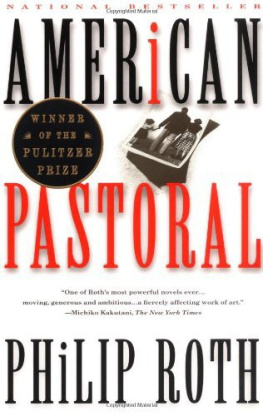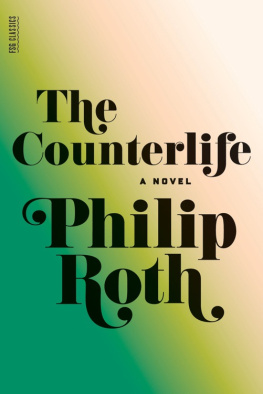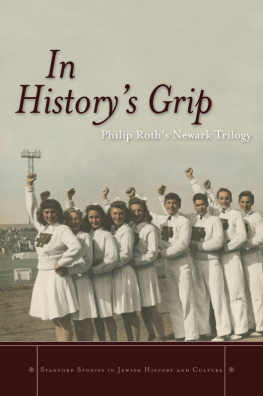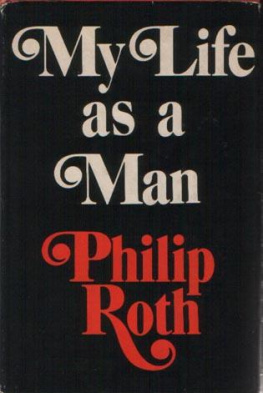Houghton Mifflin Harcourt
BOSTON NEW YORK
2010
Copyright 2010 by Philip Roth
All rights reserved
For information about permission to reproduce
selections from this book, write to Permissions,
Houghton Mifflin Harcourt Publishing Company,
215 Park Avenue South, New York, New York 10003.
www.hmhbooks.com
Library of Congress Cataloging-in-Publication Data
Roth, Philip.
Nemesis / Philip Roth.
p. cm.
ISBN 978-0-547-31835-6
I. Title.
PS 3568.0855 N 46 2010
813'.54dc22 2010026217
Book design by Robert Overholtzer
Printed in the United States of America
DOC 10 9 8 7 6 5 4 3 2 1
"I'll Be Seeing You," written by Irving Kahal and Sammy Fain,
1938 (Renewed 1966, 1994) THE NEW IRVING KAHAL
MUSIC (ASCAP)/Administered by BUG MUSIC and FAIN
MUSIC CO. All rights reserved. Used by permission. Re
printed by permission of Hal Leonard Corporation.
For H. L.
ACKNOWLEDGMENTS
Sources from which I've drawn information include The Throws Manual, by George D. Dunn, Jr., and Kevin McGill; The Encyclopedia of Religion, edited by Mircea Eliade; Teaching Springboard Diving, by Anne Ross Fairbanks; Camp Management and Recreational Programs for Summer Camps, by H. W. Gibson; Dirt and Disease, by Naomi Rogers; Polio's Legacy, by Edmund J. Sass; A Paralyzing Fear, by Nina Gilden Seavey, Jane'S. Smith, and Paul Wagner; Polio Voices, by Julie Silver and Daniel Wilson; and A Manufactured Wilderness, by Abigail Van Slyck. Particularly useful was The Book of Woodcraft, by Ernest Thompson Seton, from which I have liberally drawn on .
1. Equatorial Newark
T HE FIRST CASE of polio that summer came early in June, right after Memorial Day, in a poor Italian neighborhood crosstown from where we lived. Over in the city's southwestern corner, in the Jewish Weequahic section, we heard nothing about it, nor did we hear anything about the next dozen cases scattered singly throughout Newark in nearly every neighborhood but ours. Only by the Fourth of July, when there were already forty cases reported in the city, did an article appear on the front page of the evening paper, titled "Health Chief Puts Parents on Polio Alert," in which Dr. William Kittell, superintendent of the Board of Health, was quoted as cautioning parents to monitor their children closely and to contact a physician if a child exhibited symptoms such as headache, sore throat, nausea, stiff neck, joint pain, or fever. Though Dr. Kittell acknowledged that forty polio cases was more than twice as many as normally reported this early in the polio season, he wanted it clearly understood that the city of 429,000 was by no means suffering from what could be characterized as an epidemic of poliomyelitis. This summer as every summer, there was reason for concern and for the proper hygienic precautions to be taken, but there was as yet no cause for the sort of alarm that had been displayed by parents, "justifiably enough," twenty-eight years earlier, during the largest outbreak of the disease ever reportedthe 1916 polio epidemic in the northeastern United States, when there had been more than 27,000 cases, with 6,000 deaths. In Newark there had been 1,360 cases and 363 deaths.
Now even in a year with an average number of cases, when the chances of contracting polio were much reduced from what they'd been back in 1916, a paralytic disease that left a youngster permanently disabled and deformed or unable to breathe outside a cylindrical metal respirator tank known as an iron lungor that could lead from paralysis of the respiratory muscles to deathcaused the parents in our neighborhood considerable apprehension and marred the peace of mind of children who were free of school for the summer months and able to play outdoors all day and into the long twilit evenings. Concern for the dire consequences of falling seriously ill from polio was compounded by the fact that no medicine existed to treat the disease and no vaccine to produce immunity. Polioor infantile paralysis, as it was called when the disease was thought to infect mainly toddlerscould befall anyone, for no apparent reason. Though children up to sixteen were usually the sufferers, adults too could become severely infected, as had the current president of the United States.
Franklin Delano Roosevelt, polio's most renowned victim, had contracted the disease as a vigorous man of thirty-nine and subsequently had to be supported when he walked and, even then, had to wear heavy steel-and-leather braces from his hips to his feet to enable him to stand. The charitable institution that FDR founded while he was in the White House, the March of Dimes, raised money for research and for financial assistance to the families of the stricken; though partial or even full recovery was possible, it was often only after months or years of expensive hospital therapy and rehabilitation. During the annual fund drive, America's young donated their dimes at school to help in the fight against the disease, they dropped their dimes into collection cans passed around by ushers in movie theaters, and posters announcing "You Can Help, Too!" and "Help Fight Polio!" appeared on the walls of stores and offices and in the corridors of schools across the country, posters of children in wheelchairsa pretty little girl wearing leg braces shyly sucking her thumb, a clean-cut little boy with leg braces heroically smiling with hopeposters that made the possibility of getting the disease seem all the more frighteningly real to otherwise healthy children.
Summers were steamy in low-lying Newark, and because the city was partially ringed by extensive wetlandsa major source of malaria back when that, too, was an unstoppable diseasethere were swarms of mosquitoes to be swatted and slapped away whenever we sat on beach chairs in the alleys and driveways at night, seeking refuge out of doors from our sweltering flats, where there was nothing but a cold shower and ice water to mitigate the hellish heat. This was before the advent of home air conditioning, when a small black electric fan, set on a table to stir up a breeze indoors, offered little relief once the temperature reached the high nineties, as it did repeatedly that summer for stretches of a week or ten days. Outdoors, people lit citronella candles and sprayed with cans of the insecticide Flit to keep at bay the mosquitoes and flies that were known to have carried malaria, yellow fever, and typhoid fever and were believed by many, beginning with Newark's Mayor Drummond, who launched a citywide "Swat the Fly" campaign, to carry polio. When a fly or a mosquito managed to penetrate the screens of a family's flat or fly in through an open door, the insect would be doggedly hunted down with fly swatter and Flit out of fear that by alighting with its germ-laden legs on one of the household's sleeping children it would infect the youngster with polio. Since nobody then knew the source of the contagion, it was possible to grow suspicious of almost anything, including the bony alley cats that invaded our backyard garbage cans and the haggard stray dogs that slinked hungrily around the houses and defecated all over the sidewalk and street and the pigeons that cooed in the gables of the houses and dirtied front stoops with their chalky droppings. In the first month of the outbreakbefore it was acknowledged as an epidemic by the Board of Healththe sanitation department set about systematically to exterminate the city's huge population of alley cats, even though no one knew whether they had any more to do with polio than domesticated house cats.
What people did know was that the disease was highly contagious and might be passed to the healthy by mere physical proximity to those already infected. For this reason, as the number of cases steadily mounted in the cityand communal fear with itmany children in our neighborhood found themselves prohibited by their parents from using the big public pool at Olympic Park in nearby Irvington, forbidden to go to the local "air-cooled" movie theaters, and forbidden to take the bus downtown or to travel Down Neck to Wilson Avenue to see our minor league team, the Newark Bears, play baseball at Ruppert Stadium. We were warned not to use public toilets or public drinking fountains or to swig a drink out of someone else's soda-pop bottle or to get a chill or to play with strangers or to borrow books from the public library or to talk on a public pay phone or to buy food from a street vendor or to eat until we had cleaned our hands thoroughly with soap and water. We were to wash all fruit and vegetables before we ate them, and we were to keep our distance from anyone who looked sick or complained of any of polio's telltale symptoms.
Next page













